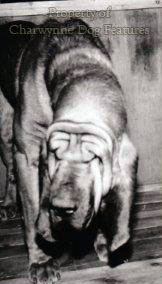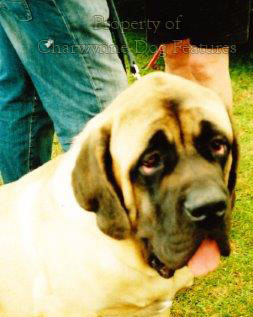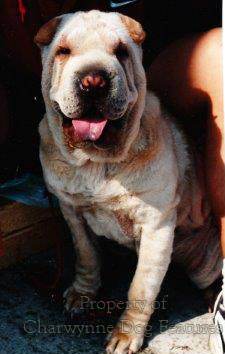666 Eyes Have It
THE EYES HAVE IT
by David Hancock

 The Bath Dog Show in May 2009 provided a good opportunity to check on the Kennel Club concept that amended breed standards and stern directions to judges on canine health was the way forward. This is my favourite dog show, one I have attended for over fifty years, man and boy. The location is stress-free, the setting relaxing and it is a show for dogs which the dogs themselves really seem to enjoy. There were the usual mixed impressions: I admired the soundness (and the very thorough judging) of the Bassets Fauve de Bretagne, a charming breed; I was impressed by the quality of the Ridgebacks but worried by the weediness of the Pointers, some of whom looked more like sighthounds; I was depressed by many of the Mastiffs and Bulldogs but so encouraged by a handsome really fit Langhaar. The lasting impression however was of bad-eyed dogs.
The Bath Dog Show in May 2009 provided a good opportunity to check on the Kennel Club concept that amended breed standards and stern directions to judges on canine health was the way forward. This is my favourite dog show, one I have attended for over fifty years, man and boy. The location is stress-free, the setting relaxing and it is a show for dogs which the dogs themselves really seem to enjoy. There were the usual mixed impressions: I admired the soundness (and the very thorough judging) of the Bassets Fauve de Bretagne, a charming breed; I was impressed by the quality of the Ridgebacks but worried by the weediness of the Pointers, some of whom looked more like sighthounds; I was depressed by many of the Mastiffs and Bulldogs but so encouraged by a handsome really fit Langhaar. The lasting impression however was of bad-eyed dogs.
Recent changes to the breed standards have seen, in the Basset Hound: deletion of 'red of lower lid appears'; in the Bloodhound: 'head furnished with only a small amount of loose skin' and 'signs of any obvious eye irritation must be heavily penalised'; Clumber Spaniels: the deletion of 'slightly sunk, some haw showing'; Mastiff: the underlining of the words 'loose eyelids highly undesirable' but no change to the word-coverage of St Bernards' eyes. But being exhibited at this KC-approved show under KC-approved judges were Bassets, Bloodhounds, Clumbers, Mastiffs and, especially St Bernards, with eyes capable of giving discomfort to the dogs. Surely the St Bernard's standard needs amending; surely judges should not permit exhibits to be shown which are in blatant breach of the recently-introduced breed standard changes.

I give the Kennel Club full marks for trying, but words are only ever a start; actions speak louder and judged on this one show, harmful anatomical flaws are being condoned, tolerated, ignored, overlooked, whichever verb you care to apply. This is not good news for dogs, it is not good news for those campaigning for healthier dogs - and I'd like to think that includes the KC. Dogs with loose lower eyelids should not be allowed in the show ring; it is a feature no breed needs, it is capable of causing distress to the dog and to exhibit a dog with such a feature shows brazen defiance to the powers that be. By what right do show ring judges permit exhibits to parade in the ring before them, and be considered for a prize, when they breach the rules? The KC has changed the words, when will they change the judges?
The eyes of any living creature are an essential element in its quality of life, why not protect its sight therefore and enhance that quality? How long would a dog last in the wild if its vision is vulnerable? Nature is crueller than any misguided dog-breeder or breed fancier. Hounds of the pack do not feature loose eye-lids because the hunters know the penalty of impaired sight and the pain of extracting grass seeds and other intrusions from vulnerable eyelids. Sighthounds have tight eyes because their eyesight is treasured. No hunting dog benefits from loose eye-lids; what a penalty for a sporting spaniel searching for ground scent in heavy cover; what a handicap for a snow rescue dog like the St Bernard. 

If you find joy in watching a setter scan the foreground or a Pointer focussing on air-scent floating its way, before 'freezing' instinctively, you appreciate fully the close link between sight and scent in sporting breeds. These two particular senses have been highly developed in such breeds by man for centuries. Both senses mean more to dogs than to us; that alone is reason enough to prize them and strive to protect them. It is believed that dogs have 20/75 vision, meaning that they are able to see clearly an object from 20 feet away that a human with normal vision would see at 75 feet away. Cats have roughly 20/100 vision and horses 20/33, closer to ours. But dogs have vastly superior night vision and detection of movement. They thrived as predators because of their combined better-developed senses of sight, hearing and smell. The low-light vision of dogs is greatly superior to ours too, facilitating hunting at night. The eyes of the dog, whatever is function, must be sound and not made more susceptible to injury.
In their authoritative 'Breed Predispositions to Disease in Dogs and Cats' (Blackwell, 2004), Gough and Thomas set out the eye problems of Basset Hounds, Bloodhounds, Clumber Spaniels, St Bernards and Mastiffs. In the Basset Hound, these are listed as entropion, ectropion, diamond eye, eversion of the cartilage of the nictitating membrane, primary glaucoma, cataract and GPRA. Hasn't the breed enough ocular problems without risking further injury through construction? They list the Bloodhound as liable to four of the same conditions of the Basset but add cherry eye and 'multiple ocular defects' too. Why inflict a further source of eye trouble on a breed?

The Clumber Spaniel's list of eye problems contains four of the Basset's, the St Bernard several more, with the Mastiff featuring the most. Why open up the sensitive parts of the eye to the risk of greater damage and infection? The commendable eye schemes now in place are being undermined by careless breeding and ignored by officiating judges; this is simply not good enough.
In their informative 'Genetic Aspects of Purebred Dogs', (Forum, 1994) Clark and Stainer write that Bassets are one of the eight breeds at a higher risk of developing glaucoma than mixed-breed dogs; that Bloodhounds are liable to malformed eye-lids, stating that the lower lid opens as a pouch, collecting debris but noting helpfully that surgical repair is usually successful! They state that excess skin on the St Bernard's head contributes to ectropion and entropion and that distichiasis is seen more frequently in this breed, recommending surgery for all three conditions. Why breed dogs which require remedial surgery - because of their breed?
Seeing dogs with bad eyes at the 2009 Bath Dog Show, being proudly shown off by their owners, with their breeders admitted in the show catalogue, being allowed to be shown by complicit judges, appointed by the KC, despite the recent rewording of their breed standards, indicates that the latter will never be enough. Ring stewards as well as judges should be instructed to draw attention to unsound proscibed exhibits; judges must now be empowered to send from the ring any dog displaying breaches of the breed standard. The standard of the St Bernard surely needs revision too. Draconian? Even Draco had standards! If we are serious about breeding healthier breeds then the nettle has to be grasped; enforcement has to be introduced...or a second TV programme will be in the making: Pedigree Dogs Exposed...Again!